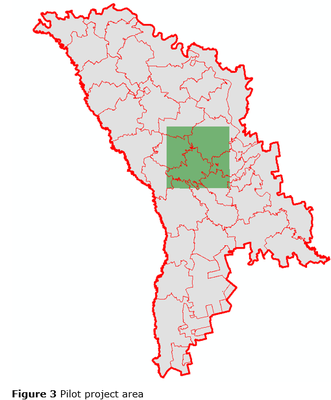ENI SEIS II East project implements pilot project in the Republic of Moldova
A Corine Land Cover (CLC) inventory for 2018 was successfully completed in the Republic of Moldova. CLC refers to a standardised data collection methodology on land cover to support environmental policy development in countries. It provides information on the biophysical characteristics of European land cover and beyond, based on Earth observation satellite data.
Land is a finite resource: how it is used constitutes one of the principal drivers of environmental change and has significant impacts on ecosystems and quality of life. In extreme cases, such changes might lead to unhealthy and degraded land. The CLC dataset is one of the bases of EU initiatives for sustainable soil and land management. It contributes to a wide range of studies, e.g. ecosystem mapping, modelling the impacts of climate change, landscape fragmentation by roads, abandonment of farmland and major structural changes in agriculture, urban sprawl and water management.
In Moldova’s case it can serve as a tool for monitoring the UN Sustainable Development Goals (SDGs) and especially SDG 15: Life on land. This targets ecosystems that are highly relevant for the Republic of Moldova, including forests and land.
Coordination of country-level activities was ensured by two formally appointed NFPs from the Environmental Agency representing the Ministry of Agriculture, Regional Development and Environment of Moldova and the National Bureau of Statistics. Remote sensing and GIS services were provided by the Agency for Land Relations and Cadastre of the Republic of Moldova through its State Enterprise Institute of Geodesy, Engineering Research and Cadastre (INGEOCAD), as the production unit.
Ten Moldovan experts were trained by the EEA through ETC/ULS experts and got hands-on experience in using various functions of the dedicated software (InterChange).
The resulting data have become part of the national spatial data infrastructure according to Law no 254 of 17 November 2016.
Moldova is the only Eastern Partnership country that had a CLC2000 database, and it was revised and updated to CLC2018 within the pilot project.
The CLC2000 in Moldova was produced by the Technical University of Moldova with technical training from Iasi University in Romania. The project was funded by the Ministry of Environment of Moldova at that time. The CLC2000 dataset was made available for verification by ETC/ULS experts and proved to be suitable to continue revising CLC2000 and mapping CLC change.
As a result, the pilot project applied the CLC methodology to the urban area of Chișinău (the largest city in Moldova) and its surroundings. Moldovan experts mapped an area of 3 158 km2 and analysed land cover changes over almost two decades (2000-2018).
The CLC pilot project in the Republic of Moldova is characterised by 18 out of 44 CLC classes. The main land cover class in the CLC pilot project area in Moldova are agricultural lands (pastures, arable land and complex cultivation patterns (62.2 %)). However, the surface area occupied by urban areas has increased to 11.5 %. Land classified as semi-natural and forest areas occupies around 24.2 % of the pilot territory.
The total area in which land cover changed between 2000 and 2018 is 1.07 % within the pilot territory, meaning that land cover in the Republic of Moldova is relatively stable in CLC resolution.
As a follow-up, the national implementation team initiated discussions with stakeholders at the national level and potential users such as the Ministry of Agriculture, Regional Development and Environment and the Environment Agency to elaborate the project proposal with the EEA’s support for CLC country-level extension.

Republic of Moldova's Environment Agency website covers information on CLC, next steps, CLC visualisation, technical report and pilot projects specification for information from technical perspective.
CLC MD can be accessed here

